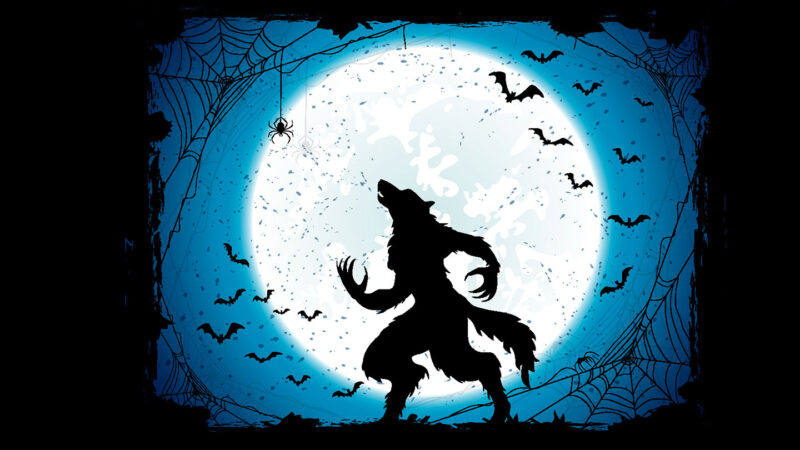As the full moon rises, a mythical werewolf howls and heads out on the hunt. But is this the best time for werewolves to find a meal? In some stories, this transformation can happen at any time of the month or even during the day. And science suggests that a careful werewolf might want to schedule their change based on their goals.
Let’s learn about the moon
The moon affects our world in several ways. As it orbits Earth, the moon pushes and pulls at the oceans to make tides. These tides can, in turn, influence the behavior of ocean creatures. And moonlight — a reflection of the sun — can also have power over the behavior of animals both on land and in the sea.
If a werewolf is all big, scary predator, the full moon might be a blessing. But if the animal could face predators itself, it might want to save its transformation for a much darker night.
Transformational timing
The dark depths of an ocean or stream might not seem like the obvious place for animals affected by the moon. But “it is something that we see pretty commonly among aquatic critters,” says Heidi Ballew. She’s a marine ecologist at Texas A&M University in Corpus Christi.
Ballew studies the ‘O‘opu nakea (Awaous stamineus), a goby native to Hawaii. The hardy little fish are born in freshwater streams in the hills. From there, a goby’s life can take two very different paths depending on when it’s born.
When the moon is full, the sun, Earth and moon are lined up. This produces higher tides. Some gobies hatch during that full moon. The higher tides sweep their tiny bodies out to sea. When they are grown, higher tides during the new moon (when the sun, moon and Earth line up again) help them find their way back to their home streams. Special fins on their bellies, modified into suckers, help them climb waterfalls back to their birthplace. There, they mate and make more gobies.
Waterfall? Not a problem. Watch a goby climb up a waterfall with her mouth and her sucker-like fin.
But not all gobies go out to see the world. Gobies born during the dark of a new moon stay home and never leave the stream where they are born.
Baby gobies are trying to avoid predation, Ballew says. “A full moon provides a high tide. But it also produces a lot of light — even underwater.” Night-hunting fish can better see tiny, defenseless gobies. So if a fish is going to stay put, hatching at the new moon is a safer bet.
The moon matters even as they grow into adults. A big, well-fed baby goby may become an adult during the full moon. But a smaller goby might become an adult at the new moon instead. The darkness hides these still-small, newly adult gobies, keeping them safe from predators. Ballew and her colleagues published their fishy findings February 26 in the journal Ecology of Freshwater Fish.
So there are pros and cons to lots of moonlight. A full moon lights up the night and makes it easy to spot dinner. But if a werewolf is as likely to become prey as it is to go hunting, a new moon might help it hide.
Predators and prey
The bright night of a full moon also presents Australian mammals with a problem, says Euan Ritchie. He’s a wildlife ecologist at Deakin University in Melbourne, Australia.
In one study, Ritchie and his colleagues took photos of animals in southeastern Australia at different phases of the moon. Prey species such as possums and rabbit-sized bandicoots were more active when nights were cloudy. The extra darkness provided cover to hide from predators.
But predators such as quolls were also more active when it was darker — when the moon was new or half. Each species was trying to find a balance between getting more food and becoming someone else’s dinner.
Don’t be fooled, this adorable creature is a fearsome predator. The spotted-tail quoll is more active when the moon is new or half — when it’s easier to pounce on prey. JJ Harrison/Wikimedia Commons (CC BY-SA 3.0)
“Predators often use ambush to capture their prey,” Ritchie says. “The lighter it is, the harder it might be [for predators] to avoid detection.” While the prey might be able to spot a predator more easily, they, too, may be more detectable. “They [might] be more hesitant to be active, especially in areas without much cover to retreat to.”
Ritchie and his colleagues published their findings in 2020 in the journal Australian Mammalogy.
Werewolves also need to find that balance between predator and prey. If a werewolf wanted to hunt as much as possible, “they would hunt humans by day and night,” Ritchie says. But being a werewolf isn’t without risk. “Many prey, including humans, are often far from harmless.”
In that case, Ballew says, a werewolf might be advised to vary its strategy. A big, strong werewolf could find good hunting during the full moon. But if a werewolf is small, young, or weak? “Maybe you would want to utilize the new moon so that your predators are less likely to find you.” It’s a lesson a werewolf could learn from the gobies that stayed home.




